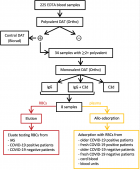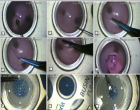Abstract
Research Article
Can bloodstream infection be predicted by nasal culture in hemodialysis patients?
Behrooz Broumand*, Shahram Boroumandi, Zahra Rahbar, Mehrdad Sheikhvatan and Maryam Shahroukh
Published: 15 April, 2019 | Volume 3 - Issue 1 | Pages: 076-082
The blood and drainage cultures are suggested for early diagnosis of bloodstream infection (BSI), which are time consuming and laborious. Nasal colonization of bacteria is one of the modalities, occasionally can predict BSI. We hypothesized that nasal culture, as an accessible fluid may be helpful to predict future BSI in hemodialysis patients. The present prospective study evaluated 63 patients undergoing maintenance hemodialysis at the Pars hospital dialysis center, Tehran, Iran, from November 2015 until February 2016. Nasal fluid of patients were collected from the 1–cm internal anterior part of both nostrils of patients by a sterile swab and cultured in Trypticase soy agar. All patients were followed for three months for BSI. The results of first nasal fluid sample revealed that 33.3% in first sampling and 27.0% in sampling had positive nasal fluid culture. The type of bacteria in all positive cases was Staphylococcus aureus. The rate of BSI infection in the patients with positive and negative first nasal fluid culture was 9.5% and 2.4% respectively with no significant difference. We found also no significant association between BSI positivity and nasal culture results so that positive BSI was revealed in 5.9% of patients with positive nasal fluid culture and 4.3% in those with negative nasal fluid culture with no meaningful difference. None of the baseline variables including age and gender, underlying risk factor, access, or duration of dialysis was associated with BSI positivity. In hemodialysis patients, BSI may not be predicted by nasal fluid culture positivity.
Read Full Article HTML DOI: 10.29328/journal.jcn.1001030 Cite this Article Read Full Article PDF
Keywords:
Infection; Renal dialysis; Nasal lavage fluid
References
- Abdel-Kader K, Unruh ML, Weisbord SD. Symptom burden, depression, and quality of life in chronic and end-stage kidney disease. Clinical Journal of the American Society of Nephrology. 2009; 4: 1057-1064. Ref.: http://tinyurl.com/y6oxqmhz
- Wasse H. Catheter‐Related Mortality among ESRD Patients. Semin Dial. 2008; Wiley Online Library. 21: 547–549. Ref.: http://tinyurl.com/yx9g73we
- Dalrymple LS, Mu Y, Romano PS, Nguyen DV, Chertow GM, et al. Outcomes of infection-related hospitalization in Medicare beneficiaries receiving in-center hemodialysis. Am J Kidney Dis. 2015; 65: 754-762. Ref.: http://tinyurl.com/y23l73uf
- Leone S, Suter F. Severe bacterial infections in haemodialysis patients. Infez Med. 2010; 18: 79-85. Ref.: http://tinyurl.com/yxfev8nm
- Karkar A. Infection control guidelines in hemodialysis facilities. Kidney Res Clin Pract. 2018; 37: 1-3. Ref.: http://tinyurl.com/yxlnrvzp
- Patel PR, Brinsley-Rainisch K. The Making Dialysis Safer for Patients Coalition: A New Partnership to Prevent Hemodialysis-Related Infections. Clin J Am Soc Nephrol. 2017; pii: CJN.02730317. Ref.: http://tinyurl.com/yyuxch6f
- Nguyen DB, Gutowski J, Ghiselli M, Cheng T, Bel Hamdounia S, et al. A Large Outbreak of Hepatitis C Virus Infections in a Hemodialysis Clinic. Infect Control Hosp Epidemiol. 2016; 37: 125-133. Ref.: http://tinyurl.com/y6fncgoh
- Malyszko J, Zawierucha J, Marcinkowski W, Prystacki T, Dryl-Rydzynska T, et al. The prevalence of hepatitis C and B among patients on hemodialysis and on renal transplantation waiting list in Poland has significantly decreased during the last 10 years. Int Urol Nephrol. 2018; 50: 1555-1556. Ref.: http://tinyurl.com/y2wjxtla
- Dalrymple LS, Mu Y, Nguyen DV, Romano PS, Chertow GM, et al. Risk Factors for Infection-Related Hospitalization in In-Center Hemodialysis. Clinical journal of the American Society of Nephrology: CJASN. 2015; 10: 2170-2180. Ref.: http://tinyurl.com/y2d5stoc
- Fram D, Taminato M, Ponzio V, Manfredi SR, Grothe C, et al. Risk factors for morbidity and mortality of bloodstream infection in patients undergoing hemodialysis: a nested case–control study. BMC research notes. 2014; 7: 882. Ref.: http://tinyurl.com/y3pukkrk
- Schmid H, Romanos A, Schiffl H, Lederer SR. Persistent nasal methicillin-resistant staphylococcus aureus carriage in hemodialysis outpatients: a predictor of worse outcome. BMC nephrology. 2013; 14: 93. Ref.: http://tinyurl.com/y45rj74f
- Verhoeven PO, Gagnaire J, Haddar CH, Grattard F, Thibaudin D, et al. Identifying Hemodialysis Patients With the Highest Risk of Staphylococcus aureus Endogenous Infection Through a Simple Nasal Sampling Algorithm. Medicine. 2016; 95: e3231. Ref.: http://tinyurl.com/y2w3awhh
- Grothe C, Taminato M, Belasco A, Sesso R, Barbosa D. Screening and treatment for Staphylococcus aureus in patients undergoing hemodialysis: a systematic review and meta-analysis. BMC nephrology. 2014; 15: 202. Ref.: http://tinyurl.com/y2wqakda
- Alcelik A, Apuhan T, Kocoglu E, Eroglu M, Necati Hakyemez I, et al. Microbial colonization of the external auditory canal and nose in hemodialysis patients. Medicinski glasnik: official publication of the Medical Association of Zenica-Doboj Canton, Bosnia and Herzegovina. 2012; 9: 330-333. Ref.: http://tinyurl.com/yy86p4fm
- Pujol M, Peña C, Pallares R, Ariza J, Ayats J, et al. Nosocomial Staphylococcus aureus bacteremia among nasal carriers of methicillin-resistant and methicillin-susceptible strains. Am J Med. 1996; 100: 509-516. Ref.: http://tinyurl.com/yyqtuggr
- Chow JW, Yu VL. Staphylococcus aureus nasal carriage in hemodialysis patients. Its rolein infection and approaches to prophylaxis. Arch Intern Med. 1989; 149: 1258-1262. Ref.: http://tinyurl.com/y6nq7crc
- Dalrymple LS, Johansen KL, Chertow GM, Cheng SC, Grimes B, et al. Infection-Related Hospitalizations in Older Patients With End-Stage Renal Disease. Am J Kidney Dis. 2010; 56: 522-530. Ref.: http://tinyurl.com/y4mb9b5j
- Fysaraki M, Samonis G, Valachis A, Daphnis E, Karageorgopoulos DE, et al. Incidence, clinical, microbiological features and outcome of bloodstream infections in patients undergoing hemodialysis. Int J Med Sci. 2013; 10: 1632-1638. Ref.: http://tinyurl.com/yywrqrgg
- Askarian M, Hajiabadi MJ, Kashkooli YA, Yousofi M, Fathi H, et al. Improving infection prevention methods in hemodialysis units: A multicenter survey. Am J Infect Control. 2014; 42: 193-194. Ref.: http://tinyurl.com/y29t5bm3
- Maki DG, Kluger DM, Crnich CJ. The risk of bloodstream infection in adults with different intravascular devices: a systematic review of 200 published prospective studies. Mayo Clin Proc. 2006; 81: 1159-1171. Ref.: http://tinyurl.com/y53d8j9o
- Gahlot R, Nigam C, Kumar V, Yadav G, Anupurba S. Catheter-related bloodstream infections. Int J Crit Illn Inj Sci. 2014; 4: 162-167. Ref.: http://tinyurl.com/y28k5ct5
- Wertheim HF, Melles DC, Vos MC, van Leeuwen W, van Belkum A, et al. The role of nasal carriage in Staphylococcus aureus infections. Lancet Infect Dis. 2005; 5: 751-762. Ref.: http://tinyurl.com/y33ergtl
- Gebreselassie HM, Lo Priore E, Marschall J. Effectiveness of meticillin-resistant Staphylococcus aureus decolonization in long-term haemodialysis patients: a systematic review and meta-analysis. J Hosp Infect. 2015; 91: 250-256. Ref.: http://tinyurl.com/y5lsbnyo
Figures:

Figure 1
Similar Articles
-
Acute Tubulointerstitial Nephritis due to Phenytoin: Case ReportNilzete Liberato Bresolin*,Pedro Docusse Junior,Maria Beatriz Cacese Shiozawa,Marina Ratier de Brito Moreira,Natalia Galbiatti Silveira. Acute Tubulointerstitial Nephritis due to Phenytoin: Case Report. . 2017 doi: 10.29328/journal.jcn.1001004; 1: 019-025
-
The outcome of Acute Kidney Injury in patients with severe MalariaJoão Egidio Romão Jr*,João Alberto Brandão. The outcome of Acute Kidney Injury in patients with severe Malaria. . 2017 doi: 10.29328/journal.jcn.1001007; 1: 048-054
-
Posterior Reversible Leukoencephalopathy Syndrome in a patient after second dose of Rituximab for treatment of resistant Thrombotic Thrombocytopenic PurpuraSabaa Asif*,Sumbal Nasir Mahmood,Osama Kunwer Naveed. Posterior Reversible Leukoencephalopathy Syndrome in a patient after second dose of Rituximab for treatment of resistant Thrombotic Thrombocytopenic Purpura . . 2018 doi: 10.29328/journal.jcn.1001010; 2: 001-004
-
Emphysematous pyelonephritis – A case series from a single centre in Southern IndiaPhanisri Alaparthi,Shobhana Nayak Rao*,Pradeep Shenoy M. Emphysematous pyelonephritis – A case series from a single centre in Southern India. . 2018 doi: 10.29328/journal.jcn.1001014; 2: 020-024
-
Three year outcomes following positive cross match renal transplantation despite failure to convert to Negative Flow Cross Match after DesensitizationShree Patel*,Jamie Benken,Patricia West Thielke,Sanjeev Akkina,Enrico Benedetti,James Thielke. Three year outcomes following positive cross match renal transplantation despite failure to convert to Negative Flow Cross Match after Desensitization . . 2018 doi: 10.29328/journal.jcn.1001016; 2: 029-038
-
Urine Leak Following Kidney Transplantation: An Evidence-based Management PlanShafiq A Chughtai,Ajay Sharma,Ahmed Halawa*. Urine Leak Following Kidney Transplantation: An Evidence-based Management Plan. . 2018 doi: 10.29328/journal.jcn.1001018; 2: 044-052
-
Liver cyst infection in kidney transplant patient with autosomal dominant polycystic kidney disease: Interest of PET/CT in diagnosis and treatmentGeorgery H*,Migali G,Pochet JM,Tintillier M,Van Ende C,Cuvelier C. Liver cyst infection in kidney transplant patient with autosomal dominant polycystic kidney disease: Interest of PET/CT in diagnosis and treatment. . 2018 doi: 10.29328/journal.jcn.1001019; 2: 053-056
-
Lessons from the success and failures of peritoneal Dialysis-Related Brucella Peritonitis in the last 16 years: Case report and Literature reviewMuhammad Bukhari*,Azharuddin Mohammed,Abdullah Al-Guraibi,Ahmed Shahata,Mansour Al-Ghamdi. Lessons from the success and failures of peritoneal Dialysis-Related Brucella Peritonitis in the last 16 years: Case report and Literature review. . 2018 doi: 10.29328/journal.jcn.1001020; 2: 057-061
-
A serious pulmonary infection secondary to disseminated Strongyloidiasis in a patient with Nephrotic syndromeMingming Ma,Shuang Cui,Ting Luo,Zhanhua Chen,Xiangnan Dong,Sibo Huang,Lianghong Yin*. A serious pulmonary infection secondary to disseminated Strongyloidiasis in a patient with Nephrotic syndrome. . 2019 doi: 10.29328/journal.jcn.1001029; 3: 071-075
-
Can bloodstream infection be predicted by nasal culture in hemodialysis patients?Behrooz Broumand*,Shahram Boroumandi,Zahra Rahbar,Mehrdad Sheikhvatan,Maryam Shahroukh. Can bloodstream infection be predicted by nasal culture in hemodialysis patients? . . 2019 doi: 10.29328/journal.jcn.1001030; 3: 076-082
Recently Viewed
-
Atypical Anti-GBM with ANCA Vasculitis- A Rarest of the Rare Entity: Index Case from Eastern IndiaGopambuj Singh Rathod*, Atanu Pal, Pallavi Mahato, Aakash Roy, Debroop Sengupta, Muzzamil Ahmad. Atypical Anti-GBM with ANCA Vasculitis- A Rarest of the Rare Entity: Index Case from Eastern India. J Clini Nephrol. 2024: doi: 10.29328/journal.jcn.1001139; 8: 124-126
-
Gallstone Ileus: A Rare Case of Intestinal Obstruction, Presented in a Chronic Kidney Disease Patient on HaemodialysisPulak Azad*,Yasir Sultan Rizvi,Lakshmi Kant Jha,Pranav Tyagi,Sachin Jain,Twinkle Malik. Gallstone Ileus: A Rare Case of Intestinal Obstruction, Presented in a Chronic Kidney Disease Patient on Haemodialysis. J Clini Nephrol. 2025: doi: 10.29328/journal.jcn.1001149; 9: 027-030
-
A Case of Rapidly Progressive Renal Failure with Unearthed AmyloidosisPulak Azad*,Lakshmi Kant Jha,Yasir Sultan Rizvi,Pranav Tyagi. A Case of Rapidly Progressive Renal Failure with Unearthed Amyloidosis. J Clini Nephrol. 2025: doi: 10.29328/journal.jcn.1001140; 9: 024-026
-
An Adult Case of Beta Thalassemia with Right Ventricular Outflow Tract Tachycardia: A Case ReportPrem AS,Shahanas PS,Praveen Sreekumar*,Ramaswamy NV. An Adult Case of Beta Thalassemia with Right Ventricular Outflow Tract Tachycardia: A Case Report. J Cardiol Cardiovasc Med. 2024: doi: 10.29328/journal.jccm.1001201; 9: 177-179
-
Autoantibodies in Autoimmune Addison’s Disease: Why are they Important?Maria Rosaria De Cagna, Norma Notaristefano, Maurizio Schiavone, Gianluca Palatella, Federica Ranù, Carmela Presicci, Valerio Cecinati, Marilina Tampoia*. Autoantibodies in Autoimmune Addison’s Disease: Why are they Important?. Arch Pathol Clin Res. 2024: doi: 10.29328/journal.apcr.1001042; 8: 012-015
Most Viewed
-
Evaluation of Biostimulants Based on Recovered Protein Hydrolysates from Animal By-products as Plant Growth EnhancersH Pérez-Aguilar*, M Lacruz-Asaro, F Arán-Ais. Evaluation of Biostimulants Based on Recovered Protein Hydrolysates from Animal By-products as Plant Growth Enhancers. J Plant Sci Phytopathol. 2023 doi: 10.29328/journal.jpsp.1001104; 7: 042-047
-
Sinonasal Myxoma Extending into the Orbit in a 4-Year Old: A Case PresentationJulian A Purrinos*, Ramzi Younis. Sinonasal Myxoma Extending into the Orbit in a 4-Year Old: A Case Presentation. Arch Case Rep. 2024 doi: 10.29328/journal.acr.1001099; 8: 075-077
-
Feasibility study of magnetic sensing for detecting single-neuron action potentialsDenis Tonini,Kai Wu,Renata Saha,Jian-Ping Wang*. Feasibility study of magnetic sensing for detecting single-neuron action potentials. Ann Biomed Sci Eng. 2022 doi: 10.29328/journal.abse.1001018; 6: 019-029
-
Pediatric Dysgerminoma: Unveiling a Rare Ovarian TumorFaten Limaiem*, Khalil Saffar, Ahmed Halouani. Pediatric Dysgerminoma: Unveiling a Rare Ovarian Tumor. Arch Case Rep. 2024 doi: 10.29328/journal.acr.1001087; 8: 010-013
-
Physical activity can change the physiological and psychological circumstances during COVID-19 pandemic: A narrative reviewKhashayar Maroufi*. Physical activity can change the physiological and psychological circumstances during COVID-19 pandemic: A narrative review. J Sports Med Ther. 2021 doi: 10.29328/journal.jsmt.1001051; 6: 001-007

HSPI: We're glad you're here. Please click "create a new Query" if you are a new visitor to our website and need further information from us.
If you are already a member of our network and need to keep track of any developments regarding a question you have already submitted, click "take me to my Query."























































































































































